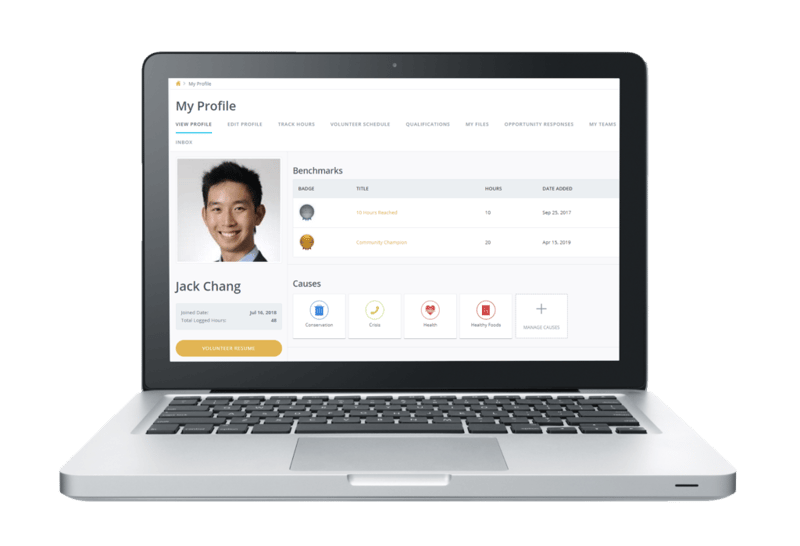People volunteer for all sorts of reasons. Some people are driven by the opportunity to work for a specific cause, while others may want to fine-tune their professional skills. Regardless of their reason, volunteers benefit from—and stay engaged by—a gamified volunteer experience.
Gamification can give your volunteers a personal sense of accomplishment and encourage engagement when they interact with your program. Leaderboards, gamified badges, contests, and ranking systems cultivate an exciting environment of competition and collaboration. The possibilities for gamifying your volunteers’ experience are endless!
In this article, we’ll cover the basics of gamification and discuss how you can use it to drive volunteer engagement.
What is gamification?
“Gamification” is adding game-elements to activities that are typically not game-related. Gamification cultivates interest, drives friendly competition, and creates incentives for participation. Used by nonprofits and for-profits alike, gamification is a successful way to drive engagement with your audience.
In fact, you’ve probably encountered gamification before, but didn’t realize it. For example, the popular language learning app, Duolingo, expertly employs the fundamentals of gamification. Duolingo’s fun and encouraging environment gently nudges their users forward with feedback, challenges, and motivation. All of this culminates in a truly compelling language-learning experience. Other popular gamified user experiences include frequent flyer programs, Fitbit, and the Starbucks Rewards program.
How Can Nonprofits Use Gamification to Drive Engagement?
You may be wondering how nonprofits benefit from gamification. Nonprofits are starting to use these principles to inform people about their cause, boost donations, change behavior, and encourage repeat volunteer engagement. As more and more digital natives make up your volunteer base, you’ll need to find ways to keep them entertained and invested in your organization. Use these 4 gamification fundamentals to drive volunteer engagement:
1. Create a Rewards Program
A rewards program is a popular way to gamify volunteer opportunities and build enthusiasm with your volunteer base. Volunteer managers can allot points based on certain volunteer achievements or milestones. These kinds of rewards systems go a long way in building value with your volunteer. Your rewards program may be based around some of the following criteria:
- Refer a friend bonuses
- Number of hours served
- Amount of hands-on work invested (for example, stuffing 50 hygiene kits or selling 100 raffle tickets)
- Impact value of volunteerism
- Number of people served
Many nonprofits encourage their volunteers to exchange their points for tshirts, prizes, or other organizational swag. This has the added benefit of marketing your organization around town.

2. Award Gamified Badges for Participation
Small rewards can go a long way in building enthusiasm for your program. In recent years, gamified badges have become very popular in the nonprofit sector. Badges are typically digital rewards that are awarded to volunteers after they have reached a predetermined milestone or benchmark. Badges have two psychological effects: they act as positive reinforcement for the volunteers’ behavior, and they encourage others to achieve the same goal.



Get creative with your badges! Think about how you can use your organization’s own branding, style, voice, or story to create a badge that’s unique to your program. Here are some examples of creative badges from The Mountaineers. They reinforce their appreciation for badge-earners by saying “award badges are given at the highest level of our organization to those who have given service, leadership and volunteerism above and beyond. Those who have one of these badges have our greatest thanks and appreciation!” Imagine how proud your volunteer will feel to visually show the community that they’ve achieved an impressively altruistic goal.
Find a volunteer management solution that incorporates gamified badges in their volunteer engagement features. Get Connected, for example, allows volunteer managers to set participation benchmarks that will automatically reward volunteers when goals are achieved. You can choose from a variety of badge designs and add custom labels; this is a fun way to show your appreciation, motivate repeat volunteerism, and encourage volunteer participation!
3. Encourage Friendly Competition
By encouraging friendly competition among your volunteers and donors, you can get participants (just a little!) rallied up and ready to make the biggest impact possible. Friendly competition can boost donation amounts and volunteer hours served. One study found that male donors, in particular, are susceptible to competition: men were four times more likely to donate money in response to a donation made by a fellow male peer.

4. Get Social
Gamification is inherently social and engaging when done right, so it naturally goes hand in hand with social media. Gamified social content is beneficial not only for getting the word out about your cause, but also for engaging volunteers beyond the end of their shift or donation.
A popularly cited gamification success story is the ALS Ice Bucket Challenge. Gamified examined why the ice bucket challenge went viral across social media channels. They found that almost every aspect of the campaign contained social gamification techniques: competition, social pressure, social status, voting, and challenging others. All of these attributes together made the Ice Bucket Challenge explode across social media and usher it into the social campaign hall of fame.
Things to keep in mind as you gamify volunteerism
Gamification is not all fun and games. As a volunteer manager, keep these best practices in mind to ensure that you maximize the fun while reducing your risk:
Protect Volunteer Privacy
Before publicly sharing any specific volunteer’s scores or success, make sure they have signed a media release form, and that they are comfortable sharing their information. Some volunteers may simply prefer to avoid the spotlight, or may have other personal reasons for not wanting their information shared publicly. Take the necessary steps to protect your volunteer’s privacy–and your organization– as much as possible.
Don’t Expect Everyone to Participate
Just because you think a gamified user-experience is awesome, does not mean that all of your volunteers will. Respect some of their choices not to participate. Ultimately, what matters most is that your volunteer is serving the community on their own terms.
Don’t Penalize Poor Performers
There is a fine line between a healthy, fun competition that boosts volunteer engagement, and a toxic culture in which you penalize those who do not perform as well as others. While you should show volunteer appreciation for accomplishments, do not publicly name volunteers who are not performing as well.
Gamification can have a major impact on volunteer engagement at your organization. It can give volunteers a personal sense of accomplishment and encourage engagement when they interact with your program. If your current volunteer management software doesn’t support some of these fundamental principals, you might consider switching your VMS to one that does.






